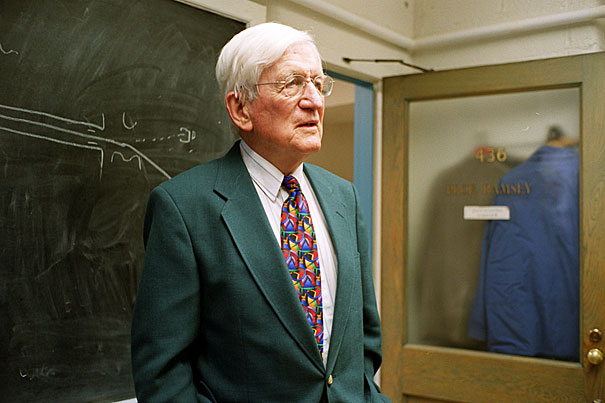
During World War II, before his nearly four decades at Harvard, Norman Ramsey led a team working on radar devices small enough to be portable, served as radar consultant to the secretary of war, and joined the Manhattan Project.
File photo Justin Ide/Harvard Staff Photographer
Nobel laureate Norman Ramsey, 96
Physicist, mentor, and statesman
Norman Ramsey, Harvard physics professor since 1947 and Nobel laureate in 1989, died peacefully in his sleep at age 96 on Nov. 4. Ramsey was widely admired for his scientific accomplishments and for his skill as a scientific statesman.
Ramsey was honored with the Davisson-Germer Prize, the Rabi Prize, IEEE Medal of Honor, the Compton Medal, the Oersted Medal, and the U.S. National Medal of Science, among many others. He also received honorary doctorates from several universities, including Oxford and Harvard.
Ramsey and his Harvard colleague Edward Purcell (Nobel laureate 1952) wondered if positive and negative charges might cancel while remaining slightly separated within an uncharged neutron. Ramsey started the search for such an “electric dipole moment” and many theoretical predictions were disproved as more precise measurements failed to discover the elusive moment. Decades later, research teams (including those of John Doyle and Gerald Gabrielse at Harvard) pursued Ramsey’s quest with even higher precision — using neutrons, electrons, and nuclei. Ever the encourager, Ramsey last year offered a financial prize for detecting an electric dipole moment during his lifetime.
The hydrogen maser was invented by Ramsey and his former Ph.D. student Dan Kleppner (now emeritus professor of physics at the Massachusetts Institute of Technology). The hydrogen atoms in this microwave version of a laser generate microwaves with a precisely defined frequency of 1,420,405,751.77 oscillations per second. Others refined this maser into a stable and robust atomic clock that does not gain or lose a second in many millions of years. The hydrogen maser keeps time precisely enough to track satellites in deep space, to test Einstein’s general relativity, to enable very long base line interferometry (VLBI) telescopes, and to make possible a global positioning system (GPS) that locates cars and container ships within a few feet, and changes in earthquake fault lines to better than an inch.
Ramsey’s “method of separated oscillatory fields” made it possible to measure molecular frequencies precisely enough to investigate small magnetic interactions, going beyond the magnetic resonance methods of his Ph.D. adviser, I.I. Rabi (Nobel laureate 1944).
At roughly the same time, Ramsey worked out the theory of chemical shifts of nuclear magnetic resonance (NMR), an essential tool of modern chemistry and structural biology. The “Ramsey method” has since been applied to many different molecules, atoms, nuclei, and particles — not the least being cesium atoms in the fountain clocks that define the internationally agreed length of a second.
Ramsey’s service as a scientific statesman included being the first head of the physics department of Brookhaven National Laboratory on Long Island. As the first assistant secretary-general for science in NATO, he established NATO fellowships and summer schools that played the role of graduate schools for a generation of European physicists. His scientific credentials and reputation for fairness played a key role in founding the Fermi National Accelerator Lab near Chicago, and for many years he was chair of the University Research Association responsible for its oversight. He was president of the American Physical Society and led the NRC committee, which with Harvard colleague Paul Horowitz concluded that acoustical evidence did not reveal a second assassin of John F. Kennedy.
During World War II, before his nearly four decades at Harvard, Ramsey led a team working on radar devices small enough to be portable, served as radar consultant to the secretary of war, and joined the Manhattan Project. Ramsey would not readily talk about the wartime part of his life. Deeply concerned about the use and long-term effect of nuclear weapons, he cautioned that it was difficult to understand the pressures of a world war in hindsight. After the war, when Sen. Joseph McCarthy labeled Harvard as “a smelly mess” and “a sanctuary for communists,” Ramsey appeared on “Meet the Press” to rebut the attacks. “True freedom,” he insisted, “gives a man not only the right to make a right choice but also the freedom to make a wrong choice.”
His colleagues celebrate Ramsey for his scientific research achievements, his effective mentoring, and his contributions as a statesman of science. He inspired many with his contagious enthusiasm, his scientific integrity, his optimistic spirit, and his zest for life.
Ramsey is survived by the four daughters he raised with his wife, Elinor, who died in 1983.
After his retirement from the teaching faculty in 1986, Ramsey lectured in several countries, sharing his love of travel and adventure with his second wife, Ellie Welch.
To read more about Ramsey’s remarkable life, visit the Nobel Prize website.




